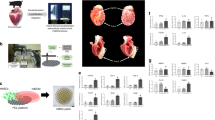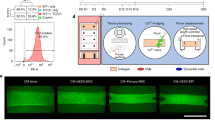Abstract
Sonic hedgehog (Shh) is a crucial regulator of organ development during embryogenesis. We investigated whether intramyocardial gene transfer of naked DNA encoding human Shh (phShh) could promote a favorable effect on recovery from acute and chronic myocardial ischemia in adult animals, not only by promoting neovascularization, but by broader effects, consistent with the role of this morphogen in embryogenesis. After Shh gene transfer, the hedgehog pathway was upregulated in mammalian fibroblasts and cardiomyocytes. This resulted in preservation of left ventricular function in both acute and chronic myocardial ischemia by enhanced neovascularization, and reduced fibrosis and cardiac apoptosis. Shh gene transfer also enhanced the contribution of bone marrow–derived endothelial progenitor cells to myocardial neovascularization. These data suggest that Shh gene therapy may have considerable therapeutic potential in individuals with acute and chronic myocardial ischemia by triggering expression of multiple trophic factors and engendering tissue repair in the adult heart.
This is a preview of subscription content, access via your institution
Access options
Subscribe to this journal
Receive 12 print issues and online access
$209.00 per year
only $17.42 per issue
Buy this article
- Purchase on Springer Link
- Instant access to full article PDF
Prices may be subject to local taxes which are calculated during checkout





Similar content being viewed by others
References
Abraham, W.T. et al. Cardiac resynchronization in chronic heart failure. N. Engl. J. Med. 346, 1845–1853 (2002).
Isner, J.M. & Losordo, D.W. Therapeutic angiogenesis for heart failure. Nat. Med. 5, 491–492 (1999).
Losordo, D.W. et al. Phase 1/2 placebo-controlled, double-blind, dose-escalating trial of myocardial vascular endothelial growth factor 2 gene transfer by catheter delivery in patients with chronic myocardial ischemia. Circulation 105, 2012–2018 (2002).
Fortuin, F.D. et al. One-year follow-up of direct myocardial gene transfer of vascular endothelial growth factor-2 using naked plasmid deoxyribonucleic acid by way of thoracotomy in no-option patients. Am. J. Cardiol. 52, 436–439 (2003).
Vale, P.R. et al. Randomized, single-blind, placebo-controlled pilot study of catheter- based myocardial gene transfer for therapeutic angiogenesis using left ventricular electromechanical mapping in patients with chronic myocardial ischemia. Circulation 103, 2138–2143 (2001).
Perin, E.C. et al. Transendocardial, autologous bone marrow cell transplantation for severe, chronic ischemic heart failure. Circulation 107, 2294–2302 (2003).
Assmus, B. et al. Transplantation of progenitor cells and regeneration enhancement in acute myocardial infarction (TOPCARE-AMI). Circulation 106, 3009–3017 (2002).
Kawamoto, A. et al. Intramyocardial transplantation of autologous endothelial progenitor cells for therapeutic neovascularization of myocardial ischemia. Circulation 107, 461–468 (2003).
Takahashi, T. et al. Ischemia- and cytokine-induced mobilization of bone marrow-derived endothelial progenitor cells for neovascularization. Nat. Med. 5, 434–438 (1999).
Yamaguchi, J. et al. Stromal cell-derived factor-1 effects on ex vivo expanded endothelial progenitor cell recruitment for ischemic neovascularization. Circulation 107, 1322–1328 (2003).
Nusslein-Volhard, C.W.E. Mutations affecting segment number and polarity in Drosophila. Nature 287, 795–801 (1980).
Wang, M. et al. Induction of the dopaminergic neuron phenotype in the midbrain by sonic hedgehog protein. Nat. Med. 1, 1184–1188 (1995).
Roelink, H. et al. Floor plate and motor neuron induction by Vhh-1, a vertebrate homologue of hedgehog expressed by the notochord. Cell 76, 761–775 (1994).
Goodrich, L. & Scott, M. Hedgehog and patched in neural development and disease. Neuron 21, 1243–1257 (1998).
Johnson, R.L. & Tabin, C.J. Molecular models for vertebrate limb development. Cell 90, 979–990 (1997).
Pepicelli, C.V., Lewis, P.M. & McMahon, A.P. Sonic hedgehog regulates branching morphogenesis in the mammalian lung. Curr. Biol. 8, 1083–1086 (1998).
Ramalho-Santos, M., Melton, D.A. & McMahon, A.P. Hedgehog signals regulate multiple aspects of gastrointestinal development. Development 127, 2763–2772 (2000).
St-Jacques, B. et al. Sonic hedgehog signaling is essential for hair development. Curr. Biol. 8, 1058–1068 (1998).
St-Jacques, B., Hammerschmidt, M. & McMahon, A.P. Indian hedgehog signaling regulates proliferation and differentiation of chondrocytes and is essential for bone formation. Genes Dev. 13, 2072–2086 (1999).
Pola, R. et al. The morphogen sonic hedgehog is an indirect angiogenic agent upregulating two families of angiogenic growth factors. Nat. Med. 7, 706–711 (2001).
Gepstein, L. et al. Electromechanical characterization of chronic myocardial infarction in the canine coronary occlusion model. Circulation 98, 2055–2064 (1998).
Fujio, Y., Nguyen, T., Wencker, D., Kitsis, R.N. & Walsh, K. Akt promotes survival of cardiomyocytes in vitro and protects against ischemia-reperfusion injury in mouse heart. Circulation 101, 660–667 (2000).
Welch, S. et al. Cardiac-specific IGF-1 expression attenuates dilated cardiomyopathy in tropomodulin-overexpressing transgenic mice. Circ. Res. 90, 641–648 (2002).
Zardoya, R., Abouheif, E. & Meyer, A. Evolution and orthology of hedgehog genes. Trends Genet. 12, 496–497 (1996).
Bitgood, M.J. & McMahon, A.P. Hedgehog and Bmp genes are coexpressed at many diverse sites of cell-cell interaction in the mouse embryo. Dev. Biol. 172, 126–138 (1995).
Kogerman, P. et al. Mammalian suppressor-of-fused modulates nuclear-cytoplasmic shuttling of Gli-1. Nat. Cell Biol. 1, 312–319 (1999).
Sisson, J.C., Ho, K.S., Suyama, K. & Scott, M.P. Costal2, a novel kinesin-related protein in the Hedgehog signaling pathway. Cell 90, 235–245 (1997).
Goodrich, L.V., Milenkovic, L., Higgins, K.M. & Scott, M.P. Altered neural cell fate and medulloblastoma in mouse patched mutants. Science 277, 1109–1113 (1997).
Pola, R. et al. Postnatal recapitulation of embryonic hedgehog pathway in response to skeletal muscle ischemia. Circulation 108, 479–485 (2003).
Asahara, T. et al. Isolation of putative progenitor endothelial cells for angiogenesis. Science 275, 964–967 (1997).
Asahara, T. et al. Bone marrow origin of endothelial progenitor cells responsible for postnatal vasculogenesis in physiological and pathological neovascularization. Circ. Res. 85, 221–228 (1999).
Roelink, H. et al. Floor plate and motor neuron induction by different concentrations of the amino-terminal cleavage product of sonic hedgehog autoproteolysis. Cell 81, 445–455 (1995).
Porter, J.A. et al. Hedgehog patterning activity: role of a lipophilic modification mediated by the carboxy-terminal autoprocessing domain. Cell 86, 21–34 (1996).
Kass, D.A. et al. Comparative influence of load versus inotropic states on indexes of ventricular contractility: experimental and theoretical analysis based on pressure-volume relationships. Circulation 76, 1422–1436 (1987).
Crabos, M., Roth, M., Hahn, A.W. & Erne, P. Characterization of angiotensin II receptors in cultured adult rat cardiac fibroblasts. Coupling to signaling systems and gene expression. J. Clin. Invest. 93, 2372–2378 (1994).
Taylor, F.R. et al. Enhanced potency of human Sonic hedgehog by hydrophobic modification. Biochemistry 40, 4359–4371 (2001).
Aikawa, R. et al. Insulin prevents cardiomyocytes from oxidative stress-induced apoptosis through activation of PI3 kinase/Akt. Circulation 102, 2873–2879 (2000).
Aikawa, R. et al. Oxidative stress activates extracellular signal-regulated kinases through Src and Ras in cultured cardiac myocytes of neonatal rats. J. Clin. Invest. 100, 1813–1821 (1997).
Goukassian, D.A. et al. Engineering the response to vascular injury: divergent effects of deregulated E2F1 expression on vascular smooth muscle cells and endothelial cells result in endothelial recovery and inhibition of neointimal growth. Circ. Res. 93, 162–169 (2003).
Acknowledgements
The authors gratefully acknowledge the secretarial assistance of M. Neely and D. Costello in the preparation of this manuscript. This work was supported by US National Institutes of Health grants HL 63414, HL 80137, HL 53354, HL P01 66957 and HL 57516 (to D.W.L.) and American Heart Association grant 0325774T (to K.F.K.).
Author information
Authors and Affiliations
Corresponding author
Ethics declarations
Competing interests
William Munger and Jeffery A. Porter are employees of Curis, Inc., which could benefit financially from commercialization of therapy studied in this article.
Supplementary information
Supplementary Fig. 1
Shh receptor Ptc1 is expressed in nucleus and cytoplasm of cardiomyocytes. (PDF 83 kb)
Supplementary Fig. 2
Shh receptor Ptc1 is expressed in nucleus and cytoplasm of cardiomyocytes. (PDF 89 kb)
Supplementary Fig. 3
Shh upregulates expression of multiple factors in adult fibroblasts. (PDF 58 kb)
Rights and permissions
About this article
Cite this article
Kusano, K., Pola, R., Murayama, T. et al. Sonic hedgehog myocardial gene therapy: tissue repair through transient reconstitution of embryonic signaling. Nat Med 11, 1197–1204 (2005). https://doi.org/10.1038/nm1313
Received:
Accepted:
Published:
Issue Date:
DOI: https://doi.org/10.1038/nm1313
This article is cited by
-
1′-O-methyl-averantin isolated from the endolichenic fungus Jackrogersella sp. EL001672 suppresses colorectal cancer stemness via sonic Hedgehog and Notch signaling
Scientific Reports (2023)
-
Signaling pathways and targeted therapy for myocardial infarction
Signal Transduction and Targeted Therapy (2022)
-
Elevated plasma endocan and BOC in heart failure patients decrease after heart transplantation in association with improved hemodynamics
Heart and Vessels (2020)
-
A conserved HH-Gli1-Mycn network regulates heart regeneration from newt to human
Nature Communications (2018)
-
Endothelial smoothened-dependent hedgehog signaling is not required for sonic hedgehog induced angiogenesis or ischemic tissue repair
Laboratory Investigation (2018)



